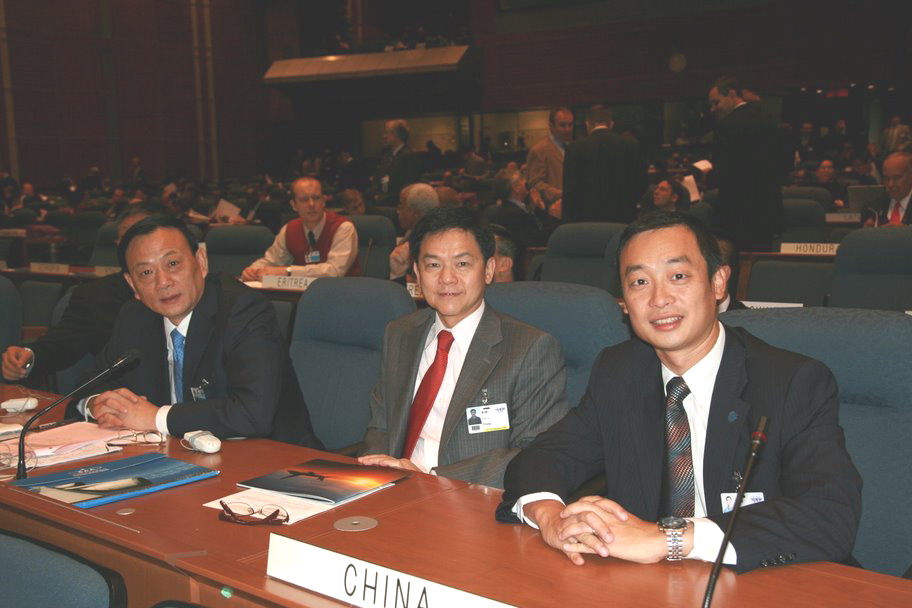
 {{_.$tools.formatDate(item.publishTime, 'yyyy-MM-dd')}} {{item.title}}
{{_.$tools.formatDate(item.publishTime, 'yyyy-MM-dd')}} {{item.title}} 
36th Session of ICAO Assembly

36th Session of ICAO Assembly 2007-09-28
The 36th Session of International Civil Aviation Organization (ICAO) Assembly, held between 18 to 28 September 2007, attracted more than 1,300 representatives from 175 countries and 43 international organizations to attend. The meeting was divided into 6 commissions: Administrative Commission, Economic Commission, Executive Commission, Legal Commission, Technical Commission and Plenary. Over 60 agenda items were discussed.
The President of the ICAO Council, Mr. Roberto Kobeh González, addressed in the opening ceremony that “Even though civil aviation remains the safest mode of mass transportation, there are too many accidents in some regions of the world. The global air transport system, while very secure, is still vulnerable to terrorist attacks. In spite of enormous progress, the sustained increase in traffic means that it will be even more difficult to minimize the impact of aviation on the environment.” For this reason, the main themes of the Assembly focused on aviation safety and security, air navigation and environmental protection.
To enhance aviation safety, ICAO developed the Global Aviation Safety Plan some years ago with the aim of reducing the accident risk for civil aviation by providing a common frame of reference for all stakeholders in order to allow a more proactive approach to aviation safety, and to help coordinate and guide safety policies and initiatives worldwide. To ensure the continuing relevance of the Plan, ICAO presented the new version of the Plan in the Assembly, which continues to provide the methodology and focus that is required to implement the ICAO Strategic Objective on safety.
Free communication of safety information amongst the stakeholders of the aviation system is recognized as an important means of ensuring the safety of international civil aviation worldwide. Despite this, the improper use of the safety information will bring about adverse effects. The Assembly therefore urges the ICAO Council to cooperate with Contracting States and appropriate international organizations regarding the development and implementation of guidance to support the establishment of effective safety reporting systems. The Assembly also urges all States which receive safety information derived from another State’s safety investigation system to respect the system of confidentiality and disclosure principles under which the providing State generated that information.
ICAO implemented its Universal Safety Oversight Audit Programme in 1999 with the aim of conducting audits on the Contracting States in personnel licensing, flight standards, airworthiness and security. The audits have proven to be instrumental in the ongoing identification and resolution of aviation safety and security concerns, and analysis reveals that the average implementation rate of the Chicago Convention Annex standards in most States has increased markedly between the period of the initial audit and the follow-up audit. The Assembly supports this programme and agrees that in order to increase the transparency of the audit programme, consideration should be given to the development of a process that will notify all member States when deficiencies identified during the course of an audit remain unaddressed for a sustained period, without divulging specific vulnerabilities.
In what regards the participation of Macao SAR in the above audit programme, the Civil Aviation Authority of Macao SAR (AACM) was audited by ICAO in the areas of personnel licensing, flight standards and airworthiness twice, respectively in 2001 and 2003. The audit results proved to be satisfactory. In addition, to support free communication of safety information and increased transparency, AACM has signed an agreement with ICAO allowing the latter to publish the audit results on the internet.
Aircraft noise and emission and the need to protect the environment have become a very important issue globally. The significant improvements to aircraft technology and operational efficiency have not been enough to neutralize the adverse effects. The Committee on Aviation Environmental Protection (CAEP), a subsidiary of the ICAO Council, has since its inception put efforts in studying for the resolution of the issue. The Assembly recognizes the work of CAEP and agrees to adopt the balance approach to reduce noise. The balance approach includes reducing the sources of noise, devising land use control, devising noise abatement operational procedures and operating restrictions on aircraft type used.
It has been alleged that aircraft contribute about 2% of the total global carbon dioxide emission. In addition, aircraft also contribute to climate change through the emission of nitrogen oxides, which are particularly effective in forming the greenhouse gas ozone. To prevent the emission issue from getting serious, the European Union (UN) issued proposed legislation in December 2006 to extend the European Union Emission Trading Scheme to civil aviation. The Scheme will request all EU carriers and foreign carriers operating to EU to comply with the restrictions on carbon dioxide emission. As such restrictions will have a big impact on the operational costs of the carriers of the developing countries, the issue has become a hot topic in the meeting. The Contracting States support environmental protection but urge that mutual agreement of States and airlines should be involved before inclusion of third parties in the Emission Trading Scheme. To this, the Assembly agrees and supports that ICAO should be the forum through which to resolve all technical issues relating to the environment.
In addition, the Assembly elected the Contracting States to be represented in the triennial Council on 22 September 2007. China was re-elected (with the highest vote: 160/167) in Part 1 Countries after its term in the 35th Assembly in 2004. The 36-member Council is categorized into Part 1, Part 2 and Part 3. Part I Countries indicate that the States are leading countries in the air transport industry. The quota in Part I Countries is 11.
The ICAO Assembly is held every 3 years and attended by the Organization’s Contracting States and aviation-related international organizations, who meet to discuss the Organization’s activities in the past 3 years and approve the work programme and the budget of the Organization for the coming 3 years. AACM participated in the 36th Assembly as members of the Chinese Delegation.
To ensure that the Macao aviation regulations and the monitoring work comply with ICAO’s Standards and Recommended Practices, AACM will continue to follow-up on the situation of its compliance with the Annexes of the Chicago Convention. AACM will reinforce its supervision on the aviation operators to create a safe, healthy and orderly environment for the local industry.

Macao SAR participated in the 36th Session of ICAO Assembly as members of the Chinese Delegation. First row from the left:Vice Minister of General Administration of Civil Aviation of China, Mr. Yang GuoQing (left), Director-General of Civil Aviation Department of Hong Kong. Mr. Norman Lo (middle) and President of Civil Aviation Authority of Macao SAR, Mr. Chan Weng Hong (right).
























